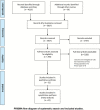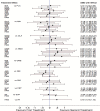Negative Symptom Interventions in Youth at Risk of Psychosis: A Systematic Review and Network Meta-analysis
- PMID: 29069511
- PMCID: PMC6007754
- DOI: 10.1093/schbul/sbx139
Negative Symptom Interventions in Youth at Risk of Psychosis: A Systematic Review and Network Meta-analysis
Erratum in
-
Erratum to: Devoe DJ, Peterson A, Addington J. Negative Symptom Interventions in Youth at Risk of Psychosis: A Systematic Review and Network Meta-Analysis.Schizophr Bull. 2018 Feb 15;44(2):463. doi: 10.1093/schbul/sbx193. Schizophr Bull. 2018. PMID: 29462457 Free PMC article. No abstract available.
Abstract
Objective: Youth at clinical high risk (CHR) for psychosis often demonstrate significant negative symptoms, which have been reported to be predictive of conversion to psychosis and a reduced quality of life but treatment options for negative symptoms remain inadequate. Therefore, we conducted a systematic review and network meta-analysis of all intervention studies examining negative symptom outcomes in youth at CHR for psychosis.
Method: The authors searched PsycINFO, Medline, Embase, CINAHL, and EBM from inception to December 2016. Studies were selected if they included any intervention that reported follow-up negative symptoms in youth at CHR for psychosis. Treatment comparisons were evaluated using both pairwise and network meta-analyses. Due to the differences in negative symptom scales the effect sizes were reported as the standardized mean difference (SMD).
Results: Of 3027 citations, 32 studies met our inclusion criteria, including a total of 2463 CHR participants. The null hypothesis was not rejected for any of the 11 treatments. N-methyl-D-aspartate-receptor (NMDAR) modulators trended toward a significant reduction in negative symptoms compared to placebo (SMD = -0.54; 95% CI = -1.09 to 0.02; I2 = 0%, P = .06). In respective order of descending effectiveness as per the treatment hierarchy, NMDAR modulators were more effective than family therapy, need-based interventions, risperidone, amisulpride, cognitive behavioral therapy, omega-3, olanzapine, supportive therapy, and integrated psychological interventions.
Conclusions: Efficacy and effectiveness were not confirmed for any negative symptom treatment. Many studies had small samples and the majority were not designed to target negative symptoms.
Figures




Similar articles
-
Attenuated psychotic symptom interventions in youth at risk of psychosis: A systematic review and meta-analysis.Early Interv Psychiatry. 2019 Feb;13(1):3-17. doi: 10.1111/eip.12677. Epub 2018 May 11. Early Interv Psychiatry. 2019. PMID: 29749710 Free PMC article.
-
Interventions and social functioning in youth at risk of psychosis: A systematic review and meta-analysis.Early Interv Psychiatry. 2019 Apr;13(2):169-180. doi: 10.1111/eip.12689. Epub 2018 Jun 25. Early Interv Psychiatry. 2019. PMID: 29938910
-
Interventions and Transition in Youth at Risk of Psychosis: A Systematic Review and Meta-Analyses.J Clin Psychiatry. 2020 May 19;81(3):17r12053. doi: 10.4088/JCP.17r12053. J Clin Psychiatry. 2020. PMID: 32433834
-
[Detection and early treatment of subjects at high risk of clinical psychosis: Definitions and recommendations].Encephale. 2017 May;43(3):292-297. doi: 10.1016/j.encep.2017.01.005. Epub 2017 Mar 25. Encephale. 2017. PMID: 28347521 Review. French.
-
Interventions for prodromal stage of psychosis.Cochrane Database Syst Rev. 2019 Nov 1;2019(11):CD012236. doi: 10.1002/14651858.CD012236.pub2. Cochrane Database Syst Rev. 2019. PMID: 31689359 Free PMC article.
Cited by
-
EPA guidance on treatment of negative symptoms in schizophrenia.Eur Psychiatry. 2021 Mar 17;64(1):e21. doi: 10.1192/j.eurpsy.2021.13. Eur Psychiatry. 2021. PMID: 33726883 Free PMC article.
-
Negative Symptoms and Functioning in Youth at Risk of Psychosis: A Systematic Review and Meta-analysis.Harv Rev Psychiatry. 2020 Nov/Dec;28(6):341-355. doi: 10.1097/HRP.0000000000000273. Harv Rev Psychiatry. 2020. PMID: 33156155 Free PMC article.
-
Multimodal prognosis of negative symptom severity in individuals at increased risk of developing psychosis.Transl Psychiatry. 2021 May 24;11(1):312. doi: 10.1038/s41398-021-01409-4. Transl Psychiatry. 2021. PMID: 34031362 Free PMC article.
-
Recent Meta-Analyses in the Clinical High Risk for Psychosis Population: Clinical Interpretation of Findings and Suggestions for Future Research.Front Psychiatry. 2018 Oct 12;9:502. doi: 10.3389/fpsyt.2018.00502. eCollection 2018. Front Psychiatry. 2018. PMID: 30369889 Free PMC article. No abstract available.
-
The Ohio State University Early Psychosis Intervention Center (EPICENTER) step-based care programme for individuals at clinical high risk for psychosis: study protocol for an observational study.BMJ Open. 2020 Jan 27;10(1):e034031. doi: 10.1136/bmjopen-2019-034031. BMJ Open. 2020. PMID: 31992606 Free PMC article.
References
-
- McGlashan T, Walsh B, Woods S.. The Psychosis-Risk Syndrome: Handbook for Diagnosis and Follow-up. New York, NY: Oxford University Press; 2010.
-
- Yung AR, Yuen HP, McGorry PD, et al. . Mapping the onset of psychosis: the Comprehensive Assessment of At-Risk Mental States. Aust N Z J Psychiatry. 2005;39:964–971. - PubMed
-
- Fusar-Poli P, Van Os J. Lost in transition: setting the psychosis threshold in prodromal research. Acta Psychiatr Scand. 2013;127:248–252. - PubMed
Publication types
MeSH terms
Substances
Grants and funding
LinkOut - more resources
Full Text Sources
Other Literature Sources
Medical
Miscellaneous

